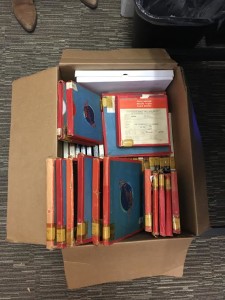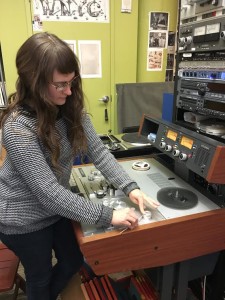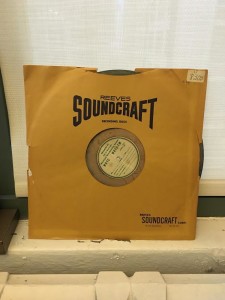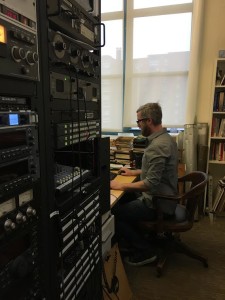
A box of reel-to-reel tape recordings originally produced by Radio Moscow for international distribution, some of which were broadcast on WNYC. These are some of hundreds of recordings that WNYC archivists Ana Marie and Ben Houtman will be digitizing over the next two years.
Alongside the work I am doing for NDSR, another monumental, grant-funded audio preservation project is underway here at NYPR’s archive. Supported and funded by the National Endowment for the Humanities, two audio digitization experts Ana Marie and Ben Houtman, both graduates of the University of Texas at Austin School of Information, will be digitizing and cataloging over 600 hours of historic recordings spanning from 1938 to 1970. The project scope includes broadcast items covering topics in the humanities, such as foreign affairs, arts and culture and media history. You can read more about the grant proposal’s aims and goals here.
In addition to their transfer work, Ana and Ben will also be posting digitized audio onto WNYC’s Archives and Preservation portal, which will allow the general public to access and listen to these unearthed sounds. Each story will include a streaming audio clip, as well as images and research to contextualize and add dimension to these storied artifacts.
I have been learning a lot from Ana and Ben about the history of WNYC and transfer techniques and tips. They are providing me a way to understand how analog signals make their way from their physical carrier to the computer, and take on new life as a digital object. Some of their ear-catching research has been incorporated into current WNYC programming, such as the bi-weekly produced segment Way Back. Surely, as this project progresses, more digitized materials will be making their way into other segments and shows. I am excited to see how NYPR producers will incorporate these sounds going forward.

Some of these tapes “shed” their binders onto the heads/spools of the transfer deck. To ensure the best possible audio is transferred from a reel-to-reel tape, Ana must remove debris from the hardware before each transfer.
A few weeks ago, I asked both Ana and Ben to speak a little bit about their backgrounds and day-to-days. Here is what they had to say:
Mary: Can you tell me about your background and how that led to you working now at NYPR?
Ana: I went to the iSchool at UT. My goal was to work with an art museum collection, but while I was in school I took classes that were collection and material-based so that I could learn more about the structure of materials and how to preserve them and about collection management methods. What was useful to me throughout school were my internships and jobs.
Mary: Any ones that stand out?
Ana: With regard to audio, my capstone project was with KUT which was the NPR affiliate in Austin. My project there was with the American Archive Content Inventory Project. I was working with recordings mainly on CD and DAT tapes.
Mary: Can you take me through what you do once you’ve transferred one of the NEH recordings to a digital broadcast WAV file?
Ana: First, I edit the file. Not extensively because it is a preservation copy, but you want to capture all of it so that if someone uses it then they can edit it to their specifications or project. Then I save the file in DAVID [NYPR’s playout application] in an NEH folder, then catalog the object in CAVAFY [NYPR’s PBcore-backed collection database]. CAVAFY will create a record for the object, where I describe it, add Library of Congress subject headings, and then add records for one or more instantiations. So, if it’s a reel-to-reel there’s only one instantiation. If it’s a lacquer disc there’s a flat instantiation and a equalized instantiation.
Mary: What do you do after you cataloging the item in CAVAFY?
Ana: If something strikes my fancy I’ll research into it a little more. For example, there was a recording of the 1966 Transit Strike. This super charming union leader named Mike Quill was about to be arrested. He was being interviewed by the press, and he had this real spitfire personality. I thought it was a really remarkable recording that might be of interest to the public. So I did a little more research into the event using the New York Times newspaper archive. He did, in fact, go to jail along with other union leaders, and this recording was made right before the police officers walked into the room to take him to jail. Once he got to jail, he became ill and had to go to the hospital. Then they settled the strike, and by the end of the month he had passed away. So that was his last great triumph.
[You can listen to Mike Quill’s interview in the embedded player below, and read Anna’s accompanying article here]:
Mary: So, you’re not just digitizing sounds. You’re also relating these things that you’re writing to images from the WNYC archive. Can you talk about that?
Ana: Sure! To have a recording online, having a dynamic image and heading is what sells the story, as in news: a good clickbait title and attention-drawing image is important if the story is going to be picked up by the Social Media Team, or just looked at through someone’s browsing site. So, I’ve also been doing research into images. For the Mike Quill recording, I contacted the New York Transit Museum to see if they had anything from that particular press conference or just any image of him. It didn’t turn out that they did – I don’t think. They looked for things regarding the strike, but didn’t find anything relating to Mike Quill. They gave me the contact information for the Robert F. Wagner Labor Union Archives, so I’m going to contact them as well.
Later, I spoke with Ben.
Mary: So, how did you get here from Texas?
Ben: I’ve been a musician for years, so I had a lot of experience with audio and using software like ProTools. I feel like what made me go to grad school for archives had a lot to do with the fact that I, for example, became obsessed with listening to jazz piano recordings. But I saw that, beyond listening, archiving allowed me to insert myself into the narrative of older forms of music, and I really like exploring the past. I ended up taking several audio preservation and reformatting classes. I also had a job at the Historical Music Recordings Collection [at the University of Texas] which is one of the 10 biggest audio archives in North America. I worked with transcription discs, did inventories and determined what shape everything was in.
Mary: So what is your day-to-day like here at WNYC?
Ben: Well, 30% of my job is dedicated to the NEH grant. Outside of that, I am working on a collection of Douglas Cooper tapes, or other archive items that the Head Archivist, Andy Lanset, needs transferred.
Mary: Ana mentioned that certain things strike her fancy that she researches further. What catches your eye?
Ben: I recently did a blog post on Dorothy Bellanca, who I consider an unsung hero of the labor movement. You don’t really see a lot about her, but she got out there and accomplished a lot. For example, when she was 19, she was on the board of the Amalgamated Clothing Workers of America. In the recording I transferred, she was running for the 8th district seat in the House of Representatives. She didn’t win it, but she had the backing of Mayor La Guardia behind her. In this recording, you get to hear La Guardia shutting down a heckler and calling someone a “Pinochle Politician” among other highlights.
[You can listen to Mayor La Guardia supporting Dorothy Bellanca’s seat in the embedded player below]:
Mary: What are one of your greatest challenges, working with these historic materials?
Ben: One pain point are that the transcription discs I am working with are often oozing palmitic and stearic acid. It’s hard to get out! I’ll scrub it three times, and try to get a good signal out of it, and the needle will still be dredging up more of the gunk.

A transcription disc in a slightly crumbly insert: one of many discs that, due to their age and composition, leak palmitic acid that can clog up the stylus. Sometimes, several cleanings are required to get a clear signal.
Ben and Ana are certainly up to some amazing work that will reveal a trove of information, unearthing new voices, and bringing perspective to the way that both leaders and everyday people communicated with one another throughout New York City and internationally. I look forward to seeing what new things they will be adding to WNYC’s website over the next two years.

